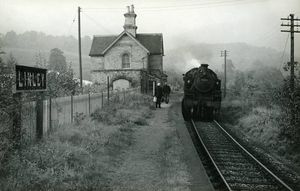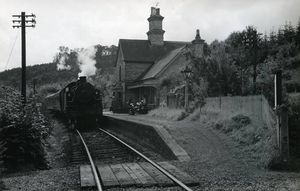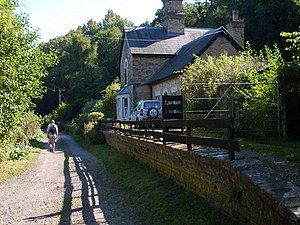Difference between revisions of "Linley"
(correction on demolition and photo added) |
(additional info and history) |
||
| Line 1: | Line 1: | ||
| − | [[File:Linley-41202-1962-10-17.jpg| | + | [[File:Linley-41202-1962-10-17.jpg|300px|thumb|Ex-LMS 41202 with a Southbound train in October 1962 ([[Sellick Collection]])]] |
| − | [[File:Linley-41202-1963-08-31.jpg| | + | [[File:Linley-41202-1963-08-31.jpg|300px|thumb|The same locomotive a year later in August 1963, this time running Northbound ([[Sellick Collection]])]] |
| − | |||
| − | |||
{| class="wikitable" | {| class="wikitable" | ||
|+Next stations pre-closure | |+Next stations pre-closure | ||
| Line 12: | Line 10: | ||
|} | |} | ||
| − | Linley Station was located 22½ miles from Hartlebury and 18¼ miles from Shrewsbury. | + | Linley Station was located 22½ miles from Hartlebury and 18¼ miles from Shrewsbury. |
| − | + | ==Construction== | |
| + | The Severn Valley Railway passes through the Apley Park estate, owned at the time of the line’s construction by Thomas C Whitmore. Although his property was located on the opposite bank of the [[River Severn]], Whitmore opposed the Railway's construction as "''utterly anihilating the privacy and seclusion of the said, mansion, house, park and grounds''", to the extent that the route authorised by the original Severn Valley Railway Act of 1853 included running the line through tunnels under the estate. Negotiations to reduce the cost of the line resulted in a revised route not including tunnels, authorised in the second Severn Valley Railway Act of 1855.<ref name=marshall>[[Bibliography#Books|Marshall (1989)]] pp. 31-36.</ref> To achieve this the Severn Valley Railway Company paid Whitmore £14,000 in compensation as well as £150 per acre for the land purchased, and in addition were required to provide a station at which at least two trains per day in each direction could be stopped on request. Linley Station, built to meet this condition, had no public access.<ref>[[Bibliography#Books|Vanns (1998)]] p. 49.</ref> | ||
| − | == | + | After the Railway opened, Whitmore cut down a number of tress so that he could have a better view of passing trains. However he died on 13 March 1865, aged only 58.<ref name=marshall/> |
| − | The | + | <br clear="all"/> |
| − | + | ==Closure== | |
| + | [[File:Linley Railway Station - geograph.org.uk - 548773.jpg|300px|thumb|Linley Station in 2007]] | ||
| + | The station had a goods siding which was closed on 10 September 1951, and the station was officially reduced to the status of a halt at the same time.<ref>[[Bibliography#Books|Marshall (1989)]] p. 107.</ref> | ||
| + | Following closure of the line in 1962, the station was converted to a private house. | ||
| + | <br clear="all"/> | ||
==See also== | ==See also== | ||
[[The Severn Valley Railway under GWR/BR ownership# Map of the Route and Nearby Railways | The Severn Valley Railway under GWR/BR ownership]] | [[The Severn Valley Railway under GWR/BR ownership# Map of the Route and Nearby Railways | The Severn Valley Railway under GWR/BR ownership]] | ||
| + | |||
| + | ==References== | ||
| + | <references /> | ||
Revision as of 14:23, 22 June 2017


| Towards Hartlebury and Kidderminster | Towards Shrewsbury |
|---|---|
| Bridgnorth (4¼ miles) | Coalport (2½ miles) |
Linley Station was located 22½ miles from Hartlebury and 18¼ miles from Shrewsbury.
Contents
Construction
The Severn Valley Railway passes through the Apley Park estate, owned at the time of the line’s construction by Thomas C Whitmore. Although his property was located on the opposite bank of the River Severn, Whitmore opposed the Railway's construction as "utterly anihilating the privacy and seclusion of the said, mansion, house, park and grounds", to the extent that the route authorised by the original Severn Valley Railway Act of 1853 included running the line through tunnels under the estate. Negotiations to reduce the cost of the line resulted in a revised route not including tunnels, authorised in the second Severn Valley Railway Act of 1855.[1] To achieve this the Severn Valley Railway Company paid Whitmore £14,000 in compensation as well as £150 per acre for the land purchased, and in addition were required to provide a station at which at least two trains per day in each direction could be stopped on request. Linley Station, built to meet this condition, had no public access.[2]
After the Railway opened, Whitmore cut down a number of tress so that he could have a better view of passing trains. However he died on 13 March 1865, aged only 58.[1]
Closure
The station had a goods siding which was closed on 10 September 1951, and the station was officially reduced to the status of a halt at the same time.[3]
Following closure of the line in 1962, the station was converted to a private house.
See also
The Severn Valley Railway under GWR/BR ownership
References
- ↑ 1.0 1.1 Marshall (1989) pp. 31-36.
- ↑ Vanns (1998) p. 49.
- ↑ Marshall (1989) p. 107.
